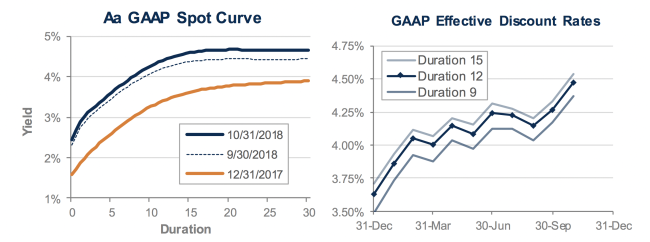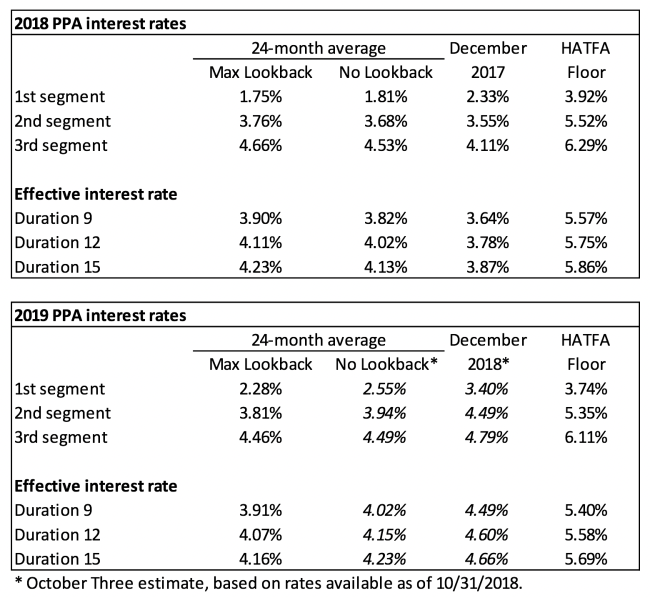October 2018 Pension Finance Update
October was a scary month for pensions – treats turned to tricks as stock markets gave back most of what they had earned this year. Interest rates “rising from the dead”, so to speak, softened the blow a bit, but both model plans we track[1] suffered their worst month of the year, with traditional Plan A dropping almost 4% and the more conservative Plan B losing almost 2%. For the year, however, Plan A remains 5% up and Plan B is ahead a fraction of 1%.
October was a scary month for pensions – treats turned to tricks as stock markets gave back most of what they had earned this year. Interest rates “rising from the dead”, so to speak, softened the blow a bit, but both model plans we track[1] suffered their worst month of the year, with traditional Plan A dropping almost 4% and the more conservative Plan B losing almost 2%. For the year, however, Plan A remains 5% up and Plan B is ahead a fraction of 1%:

Assets
How ghoulish were stocks in October? Well, the S&P 500 lost almost 7% — the bellwether’s worst month in more than seven years – yet it still managed to outperform other stock indexes. NASDAQ dropped 9%, the small-cap Russell 2000 fell almost 11%, and the overseas EAFE index slid 8%. For the year, the S&P 500 is still up 3% and the NASDAQ is ahead 6%, but the Russell 2000 is down almost 1% and the EAFE index has lost a frightening 10%.
A diversified stock portfolio lost more than 8% in October and is now flat for the year.
Bonds lost 1%-2% last month, as interest rates moved up about 0.2%. Through October, a diversified bond portfolio is down 4%-6%, with long duration bonds and corporates doing worst.
Overall, our traditional 60/40 lost more than 5% in October and is now down 2% for the year, while the conservative 20/80 portfolio lost almost 3% last month and is now down 5% through the first ten months of 2018.
Liabilities
Pension liabilities (for funding, accounting, and de-risking purposes) are now driven by market interest rates. The graph on the left compares our Aa GAAP spot yield curve at December 31, 2017, and October 31, 2018, and it also shows the movement in the curve last month. The graph on the right shows our estimate of movements in effective GAAP discount rates for pension obligations of various duration during 2018:

Corporate bond yields rose 0.2% during October, pushing pension liabilities down 1%-2%. For the year, liabilities remain down 5%-8%, with long duration plans seeing the biggest drops.
Summary
While pension assets have now earned a negative return during 2018, funded status has improved due to the power of higher interest rates – rates have increased around 0.8% this year and are now at their highest level in nearly five years. However, a year that looked so promising just a month ago is now in danger of turning into a pumpkin. The graphs below show the movement of assets and liabilities for our two model plans so far this year:

Looking Ahead
Congress passed a budget in 2015 that includes a third round of pension funding relief since 2012. The persistence of historically low interest rates, however, means that pension sponsors that have only made required contributions will see contributions ramp up in the next few years as the impact of relief fades (barring a continued surge in long-term rates).
Discount rates rose about 0.2% last month. We expect most pension sponsors will use effective discount rates in the 4.3%-4.7% range to measure pension liabilities right now.
The table below summarizes rates that plan sponsors are required to use for IRS funding purposes for 2018, along with estimates for 2019. Pre-relief, both 24-month averages and December ‘spot’ rates, which are still required for some calculations, such as PBGC premiums, are also included.

[1] Plan A is a traditional plan (duration 12 at 5.5%) with a 60/40 asset allocation, while Plan B is a largely retired plan (duration 9 at 5.5%) with a 20/80 allocation with a greater emphasis on corporate and long-duration bonds. We assume overhead expenses of 1% of plan assets per year, and we assume the plans are 100% funded at the beginning of the year and ignore benefit accruals, contributions, and benefit payments in order to isolate the financial performance of plan assets versus liabilities.
